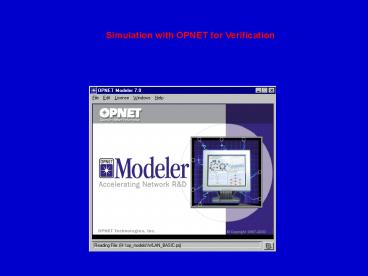Opnet Simulation ppt - PowerPoint PPT Presentation
1 / 20
Title:
Opnet Simulation ppt
Description:
Access Point Functionality is enabled for server. Workstation Settings. Mostly default values ... l = 300 mt. Lm = 8000 bits. ? = 40 bit/sec. Two teams ... – PowerPoint PPT presentation
Number of Views:1094
Avg rating:5.0/5.0
Title: Opnet Simulation ppt
1
Simulation with OPNET for Verification
2
System Architecture
- Campus model wireless Lan
- Transmission medium is air.
- 1 server, 11 Nodes Star Topology
- Each node produces Email, fttp
- http and voice traffic according
- to the specified distribution.
- Center node relays all traffic.
- Application configuration
- which apps are going to be
- simulated.
- Profile configuration
- creates a profile that uses these
- apps configured in application
- configuration.
3
Server Settings
- Mostly default values
- Created profile is used for
- Application supported services
- Name and model are defined
- Detailed configuration are made
- in Lan Parameters menu
4
Lan Parameters
- Data Rate is changed to 2 Mbps.
- Access Point Functionality is enabled for server
5
Workstation Settings
- Mostly default values
- Created profile is used for
- Application supported profiles
- Name and model are defined
- Detailed configuration are made
- in Lan Parameters menu
6
Simulation Configuration
- Simulation duration is 1 hr.
- Wireless Lan range is 300 mt.
- Also the required reports are
- chosen.
- Throughput
- Delay
- Lan Load
7
Running Simulation
- It took 23 seconds to run the
- simulation.
- The simulation was run twice
- first with Uniform Distribution for
- message arrivals
- second with Poisson Distribution
8
Simulation Reports for Server (Uniform Dist.)
Uniform Distribution min Outcome 0 max
Outcome 1000
Load (bits/sec) Min 0 Max 6000 Mean
4200
Delay (sec) Min 0.0004 Max 0.0024
Mean 0.0014
Throughput (bits/sec) Min 0 Max 5000
Mean 3900
9
Simulation Reports for Workstation 1 (Uniform
Dist.)
Load (bits/sec) Min 0 Max 400 Mean
330
Delay (sec) Min 0.0004 Max 0.0007
Mean 0.0006
Throughput (bits/sec) Min 0 Max 1200
Mean 990
10
Simulation Reports for Server (Poisson Dist.)
Poisson Distribution mean Outcome 500
Load (bits/sec) Min 0 Max 3800 Mean
3300
Delay (sec) Min 0 Max 0.0022 Mean
0.0015
Throughput (bits/sec) Min 0 Max 2100
Mean 1400
11
Simulation Reports for Workstation 1 (Poisson
Dist.)
Load (bits/sec) Min 0 Max 290 Mean
220
Delay (sec) Min 0 Max 0.0007 Mean
0.0006
Throughput (bits/sec) Min 0 Max 800
Mean 690
12
Comparison Analytical versus Simulation
l 300 mt. Lm 8000 bits ? 40 bit/sec
13
Two teams structure with command center
- Two teams and command center
- system.
- Both subnets are connected to
- the command center (router).
- Center router acts as a relay
- station between the subnets.
- Same distributions are used to
- simulate the traffic.
- All system settings are same with
- the previous model.
14
Inside the Subnet
- Subnets are identical.
- 1 server (access point), 11 nodes
- Center node relays all traffic
- between the nodes and acts as
- a gateway for the subnet.
- Each node produces Email, fttp
- http and voice traffic according
- to the specified distribution.
- Distances between nodes and the
- center is 300 m., data rate 2Mbps.
15
Access Point 1
Load (bits/sec) Min 0 Max 350 Mean
240
Delay (sec) Min 0 Max 0.0008 Mean
0.0005
Throughput (bits/sec) Min 0 Max 120
Mean 90
16
Access Point 2
Load (bits/sec) Min 0 Max 120 Mean
90
Delay (sec) Min 0 Max 0.00025 Mean
0.0002
Throughput (bits/sec) Min 0 Max 100
Mean 80
17
Server 1
Load (bits/sec) Min 0 Max 120 Mean
90
Delay (sec) Min 0.00008 Max 0.00022
Mean 0.00018
8
Throughput (bits/sec) Min 0 Max 170
Mean 110
18
Server 2
Load (bits/sec) Min 0 Max 70 Mean
50
Delay (sec) Min 0 Max 0.00022 Mean
0.00018
Throughput (bits/sec) Min 0 Max 100
Mean 60
19
Conclusions
- According to the analytical method, the mean
total delay of the system is 8 ms. - This value is verified as 8 ms, with the
simulation model. - The mean total delay is mostly affected by the
message size and the arrival rate - The other variable is the distances between the
nodes and the central node. - We have assumed that the distances are
constant. To get more realistic results - the distances can be represented with a
distribution.
20
Conclusions
- This project was a good hands-on experience to
understand the concepts - we covered in the course
- The simulation tool that we have used, is very
powerful, however we have - spent a long time to make it work.
- Opnet Modeler is not user-friendly. It requires
a special training.































